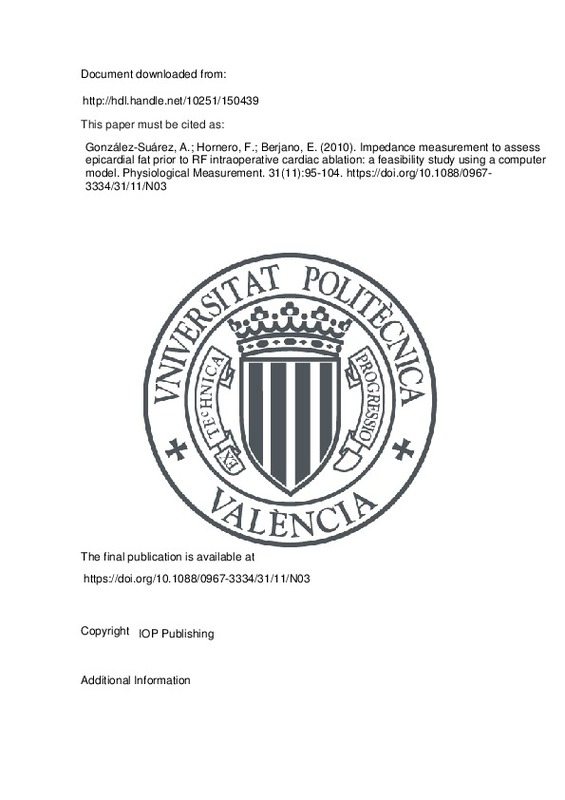Ba, M., Fornés, P., Nutu, O., Latrémouille, C., Carpentier, A., & Chachques, J. C. (2008). Treatment of atrial fibrillation by surgical epicardial ablation: Bipolar radiofrequency versus cryoablation. Archives of Cardiovascular Diseases, 101(11-12), 763-768. doi:10.1016/j.acvd.2008.07.004
Benjamin, E. J. (1994). Independent risk factors for atrial fibrillation in a population-based cohort. The Framingham Heart Study. JAMA: The Journal of the American Medical Association, 271(11), 840-844. doi:10.1001/jama.271.11.840
Berjano, E. J., & Hornero, F. (2004). Thermal-Electrical Modeling for Epicardial Atrial Radiofrequency Ablation. IEEE Transactions on Biomedical Engineering, 51(8), 1348-1357. doi:10.1109/tbme.2004.827545
[+]
Ba, M., Fornés, P., Nutu, O., Latrémouille, C., Carpentier, A., & Chachques, J. C. (2008). Treatment of atrial fibrillation by surgical epicardial ablation: Bipolar radiofrequency versus cryoablation. Archives of Cardiovascular Diseases, 101(11-12), 763-768. doi:10.1016/j.acvd.2008.07.004
Benjamin, E. J. (1994). Independent risk factors for atrial fibrillation in a population-based cohort. The Framingham Heart Study. JAMA: The Journal of the American Medical Association, 271(11), 840-844. doi:10.1001/jama.271.11.840
Berjano, E. J., & Hornero, F. (2004). Thermal-Electrical Modeling for Epicardial Atrial Radiofrequency Ablation. IEEE Transactions on Biomedical Engineering, 51(8), 1348-1357. doi:10.1109/tbme.2004.827545
Berjano, E. J., & Hornero, F. (2005). A cooled intraesophageal balloon to prevent thermal injury during endocardial surgical radiofrequency ablation of the left atrium: a finite element study. Physics in Medicine and Biology, 50(20), N269-N279. doi:10.1088/0031-9155/50/20/n03
HORNERO, F., & BERJANO, E. J. (2006). Esophageal Temperature During Radiofrequency-Catheter Ablation of Left Atrium: A Three-Dimensional Computer Modeling Study. Journal of Cardiovascular Electrophysiology, 17(4), 405-410. doi:10.1111/j.1540-8167.2006.00404.x
Cox, J. L., Schuessler, R. B., Lappas, D. G., & Boineau, J. P. (1996). An 8½-Year Clinical Experience with Surgery for Atrial Fibrillation. Annals of Surgery, 224(3), 267-275. doi:10.1097/00000658-199609000-00003
Deneke, T., Khargi, K., Müller, K.-M., Lemke, B., Mügge, A., Laczkovics, A., … Grewe, P. H. (2005). Histopathology of intraoperatively induced linear radiofrequency ablation lesions in patients with chronic atrial fibrillation. European Heart Journal, 26(17), 1797-1803. doi:10.1093/eurheartj/ehi255
Doss, J. D. (1982). Calculation of electric fields in conductive media. Medical Physics, 9(4), 566-573. doi:10.1118/1.595107
Dumas III, J. H., Himel IV, H. D., Kiser, A. C., Quint, S. R., & Knisley, S. B. (2008). Myocardial electrical impedance as a predictor of the quality of RF-induced linear lesions. Physiological Measurement, 29(10), 1195-1207. doi:10.1088/0967-3334/29/10/004
Gabriel, S., Lau, R. W., & Gabriel, C. (1996). The dielectric properties of biological tissues: III. Parametric models for the dielectric spectrum of tissues. Physics in Medicine and Biology, 41(11), 2271-2293. doi:10.1088/0031-9155/41/11/003
Suárez, A. G., Hornero, F., & Berjano, E. J. (2010). Mathematical Modeling of Epicardial RF Ablation of Atrial Tissue with Overlying Epicardial Fat. The Open Biomedical Engineering Journal, 4(1), 47-55. doi:10.2174/1874120701004020047
Hong, K. N., Russo, M. J., Liberman, E. A., Trzebucki, A., Oz, M. C., Argenziano, M., & Williams, M. R. (2007). Effect of Epicardial Fat on Ablation Performance: A Three-Energy Source Comparison. Journal of Cardiac Surgery, 22(6), 521-524. doi:10.1111/j.1540-8191.2007.00454.x
Kannel, W. ., Wolf, P. ., Benjamin, E. ., & Levy, D. (1998). Prevalence, incidence, prognosis, and predisposing conditions for atrial fibrillation: population-based estimates 11Reprints are not available. The American Journal of Cardiology, 82(7), 2N-9N. doi:10.1016/s0002-9149(98)00583-9
Khargi, K., Hutten, B. A., Lemke, B., & Deneke, T. (2005). Surgical treatment of atrial fibrillation; a systematic review☆. European Journal of Cardio-Thoracic Surgery, 27(2), 258-265. doi:10.1016/j.ejcts.2004.11.003
Mitnovetski, S., Almeida, A. A., Goldstein, J., Pick, A. W., & Smith, J. A. (2009). Epicardial High-intensity Focused Ultrasound Cardiac Ablation for Surgical Treatment of Atrial Fibrillation. Heart, Lung and Circulation, 18(1), 28-31. doi:10.1016/j.hlc.2008.08.003
Miyagi, Y., Ishii, Y., Nitta, T., Ochi, M., & Shimizu, K. (2009). Electrophysiological and Histological Assessment of Transmurality after Epicardial Ablation Using Unipolar Radiofrequency Energy. Journal of Cardiac Surgery, 24(1), 34-40. doi:10.1111/j.1540-8191.2008.00747.x
Pruitt, J. C., Lazzara, R. R., & Ebra, G. (2007). Minimally invasive surgical ablation of atrial fibrillation: The thoracoscopic box lesion approach. Journal of Interventional Cardiac Electrophysiology, 20(3), 83-87. doi:10.1007/s10840-007-9172-3
Santiago, T., Melo, J., Gouveia, R. H., Neves, J., Abecasis, M., Adragão, P., & Martins, A. P. (2003). Epicardial radiofrequency applications: in vitro and in vivo studies on human atrial myocardium☆. European Journal of Cardio-Thoracic Surgery, 24(4), 481-486. doi:10.1016/s1010-7940(03)00344-0
Santiago, T., Melo, J. oã. Q., Gouveia, R. H., & Martins, A. P. (2003). Intra-atrial temperatures in radiofrequency endocardial ablation: histologic evaluation of lesions. The Annals of Thoracic Surgery, 75(5), 1495-1501. doi:10.1016/s0003-4975(02)04990-1
Wolf, P. A., Abbott, R. D., & Kannel, W. B. (1991). Atrial fibrillation as an independent risk factor for stroke: the Framingham Study. Stroke, 22(8), 983-988. doi:10.1161/01.str.22.8.983
[-]







![[Cerrado]](/themes/UPV/images/candado.png)


